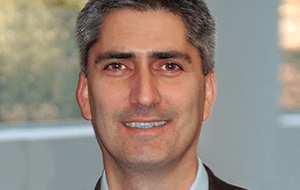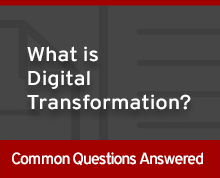Navigating a minefield of buzzwords and jargon is par for the course for today's CIO, often times making it difficult to separate real opportunities from the hype that surrounds them. Adam Dennison, senior vice president and publisher of IDG Enterprise, does his part to help CIOs cut through the noise by producing events that are hyper focused on the most pressing issues facing IT leaders, such as the upcoming AGENDA16, March 21-23 in Amelia Island, Florida. From “digital transformation,” to “IT-business alignment,” to “the D-suite,” we caught up with Dennison to discuss how the trends of the moment are shaping the day-to-day challenges and responsibilities of CIOs.

The Enterprisers Project (TEP): Is digital transformation just a passing buzzword, or is it here to stay?
 Adam Dennison: It’s interesting. I’ve been in this industry since 2000, and there are always buzzwords that come and go. Cloud was a buzzword, and still is. So is big data, and people are getting fed up with that one now, as well. Consumerization is the one that I look at as the precursor to digital transformation. Consumerization, as a buzzword, was so big and encapsulating and then it seemed to just die, right? No one talks about it anymore. I think it's still important, but it's morphed into what we now know as digital transformation or digital enterprise.
Adam Dennison: It’s interesting. I’ve been in this industry since 2000, and there are always buzzwords that come and go. Cloud was a buzzword, and still is. So is big data, and people are getting fed up with that one now, as well. Consumerization is the one that I look at as the precursor to digital transformation. Consumerization, as a buzzword, was so big and encapsulating and then it seemed to just die, right? No one talks about it anymore. I think it's still important, but it's morphed into what we now know as digital transformation or digital enterprise.
To me, when I think about digital, I think about it from a tech stack standpoint. I think about data, I think about cloud, and I think about mobile. And the customer is at the intersection of all of those. The term “customer” has to be involved when you think about digital and how to leverage those three technologies to better understand and better serve your customers – both internal and external.
I don’t know how long digital, as a trend or industry focus, is going to have legs. But because it encompasses all those things – the customer, the tech stack, etc – I think it means more than the over-hyped buzzwords of the past, and therefore has staying power.
TEP: As technology moves closer to the center of business, where does the responsibility of the CIO overlap with other line of business leaders?
Dennison: People say, “Every company is a software company now.” If that’s the case, then everybody is a technologist, as well. I hate the terminology of “IT and the business,” but sometimes I can’t get out of saying it because I don’t have a better way to phrase it. No one says finance and the business; no one says marketing and the business; and no one says sales and the business. But the fact remains that enterprise IT needs to be more engrained and embedded in the business than they ever have been before.
 Look, I make a living off of vendors trying to get to IT folks. But the reality is that the purchase process and the collaborative nature that it's come to be means that it’s fractured. We know in an enterprise there are 17 different influencers or decision makers on a major IT purchase, and, in many cases, there is a lot more than that. So, to think that it’s all encapsulated within IT is very short sighted.
Look, I make a living off of vendors trying to get to IT folks. But the reality is that the purchase process and the collaborative nature that it's come to be means that it’s fractured. We know in an enterprise there are 17 different influencers or decision makers on a major IT purchase, and, in many cases, there is a lot more than that. So, to think that it’s all encapsulated within IT is very short sighted.
Now, to that point, our friends at Gartner made the claim that the CMO is going to have a bigger IT budget than the CIO by 2017. But I think they are way off base. All of our research points to the fact that that’s not even going to come close to being true. But it is true that more line of business folks are involved than in the past.
TEP: How can CIOs become more aligned with their business partners on digital?
Dennison: We are trying to help CIOs with this by bringing more line of business leaders into the fold at our events. The digital issues that we discuss go well beyond IT, and the conversations that take place on stage are precisely what CIOs should be talking about with their line of business folks.
We're going beyond IT at AGENDA16 in a number of ways. One is our Digital Edge award. It’s an organizational award, and in order to submit for that, you have to have two business leaders involved - one who sits within IT, and one who sits within another functional area. It could be marketing, it could be HR, it could be operations, it could be sales, etc., but it has to have both sides represented.
Another thing we are doing, whenever we are invite folks to attend, we say to them, “Do you have another functional counterpart that you would like to bring?” Our CIO Executive Council, a paid advisory group that sits within the IDG family, is doing the same. They are trying to branch out, as well, into what they call the D-suite, the digital suite. The third area that we do this is on stage. We regularly bring CEOs on stage to discuss what they are doing from a digital perspective, which I think helps to broaden the conversation.
TEP: What else are you doing at AGENDA16 to help both CIOs and their business peers better understand digital and the opportunities ahead?
Dennison: There is going to be a point at AGENDA when we shut down the main stage for two hours and give folks the option to do one of three things. One of them will be around digital transformation from a vision and governance perspective, one will be around women in leadership, and the other one is around next-gen leadership. So, if you’re in that mid-to-high-level role right now and you want to be an executive or C-suite member, our workshop will look at what it takes to get there. We think those three topics really encompass the most relevant opportunities for business leaders today.
The theme for this year’s AGENDA16 conference is “Building the Digital Business.” The event runs from March 21-23 in Amelia Island, Florida. For more information, or to register: https://www.agendaconference.com.




